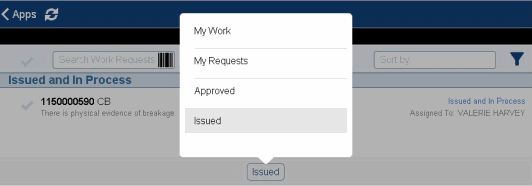
An important part of a craftsperson's role in resolving a maintenance issue is updating the ARCHIBUS system with details about the jobs they complete. For example, craftspersons must access the ARCHIBUS system to put a job on hold, record the hours spent on the job, enter notes about how they resolved the problem, enter the parts used on the job, and so forth.
With the ARCHIBUS Maintenance mobile app, craftspersons in the field can use a smart phone or other mobile device to perform everyday tasks that they encounter on the job.
Craftspersons toggle between the following tabs to perform their work.
| Tab | Purpose |
|---|---|
| My Work | To view and process the work in their queue. This tab shows work assigned to the craftsperson regardless of its status; that is, this tab will show work that is requested, on hold, issued. It also includes completed work not yet uploaded to the server. |
| My Requests | To review the work they have requested but have not yet uploaded to the server by syncing. From this tab, they can add further details to their initial request. |
| Approved | To self-assign work (if the facility manager has established this feature). |
| Issued | To process work that is issued. This tab shows work assigned to the craftsperson that has a status of "Issued and in Process." The craftsperson can process work from either this tab or from the My Work tab. |
To access these tabs, the craftsperson clicks on the button (named according to the currently displayed tab) located at the bottom of the screen and to access the list of available tabs.

Following are the main tasks of the craftsperson:
Once maintenance work is approved, the service request system of the ARCHIBUS On Demand and Preventive Maintenance systems automatically routes work to craftspersons based upon defined procedures. To see the work routed to them, craftspersons move to the My Work tab on the mobile device and run the Sync action, which downloads from the server work that has been routed to them . Since maintenance situations might arise throughout the day, craftspersons can periodically run the sync action throughout the day to see their latest task list.
The system color-codes the jobs based on when they should be executed:
If they have a lot of assigned work in their queue, craftspersons may wish to search for specific work requests and sort their assigned work requests using the boxes at the top of the screen.
Work requests can be sorted by escalation, location, status, and problem type. For example, the below image shows work requests sorted by location. Sorting by location is useful because craftspersons can look up all their assigned work for a particular location. They can then gather all tools and parts that they will need for the jobs in and near this location and avoid making multiple trips back to the supply room. For more information, see Searching, Filtering, and Sorting.
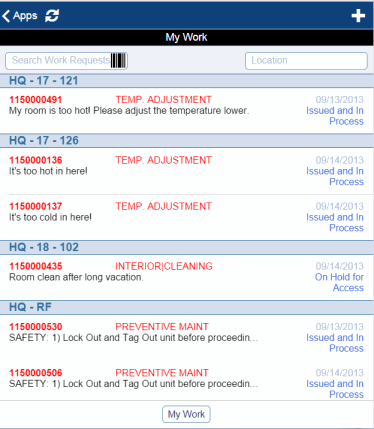
Craftspersons can search for work requests by entering their search criteria in the Search Work Requests box in the upper left corner of the My Work screen. Craftspersons can search on:
From the My Work list, craftspersons access a list of the jobs assigned to them. They can tap any job and review the description of the problem, priority, location, and other details. If they are not sure the location of the room, they can look it up on the floor plan using the Locate button (the button shaped like an explanation point in the top left of the screen). They can then proceed to the site and get started with the assigned jobs. 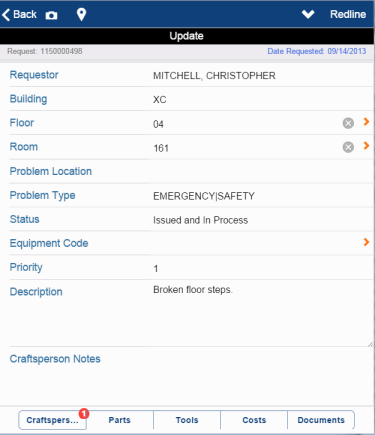
Directly from the mobile device, craftspersons can record the time, parts, costs, and other details of the job, either while the job is in process or when it is finished and before they run the Complete action. They do so by using the following buttons, located at the bottom of the screen. When they sync the device, all cost information (labor, parts, and other costs) is uploaded to the ARCHIBUS database on the server.
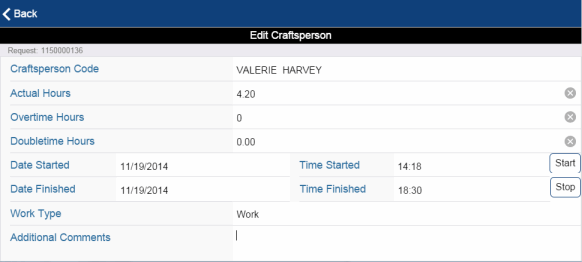
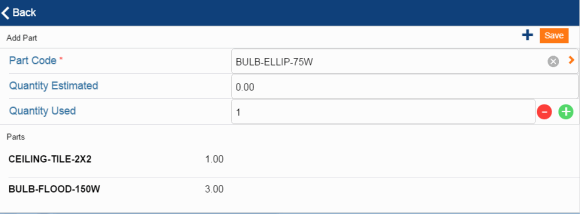
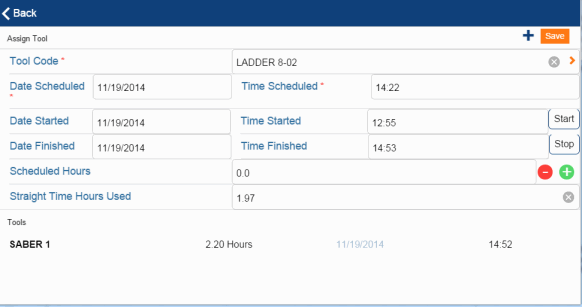
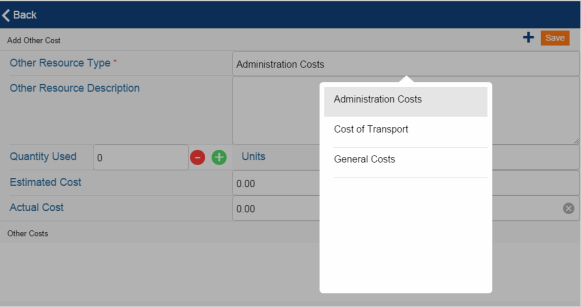
While addressing a job or reporting a new one, craftspersons may want to document the damage by taking a picture of the affected area or marking the damaged area on a floor plan. From both the Update Work Request and Create Work Request screens, the craftsperson can do the following:
When craftspersons sync their devices and upload these documents to the ARCHIBUS server, supervisors and other managers will have documentation on the issues and may be able to use these pictures in cost justification or maintenance analysis.
Sometimes, work cannot proceed and a job must be placed on hold. Craftspersons can enter comments about the situation and then tap the Hold button to specify that they are putting the job on hold because of:
Additionally, once a work request is put on hold, the craftsperson can cancel the hold status when work can resume on the job. The craftsperson taps the Hold button and chooses the "Resume to Issued" option to reset the work's status to "Issued and in Process."
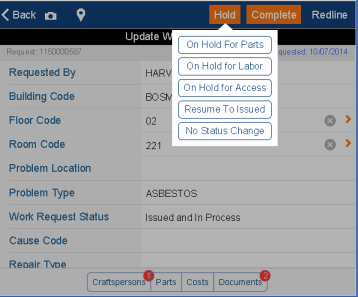
When the craftsperson syncs the device, the sync action uploads this information to the server. The work request system then informs the requestor that the job is on hold or has been resumed.
Note: When placing a work request on hold or when resuming work, craftspersons should be aware that they are not immediately updating the server with their status changes. They need to sync after each action in order for their changes to be uploaded to the server so that the work order system (the SLAs) can process the item and send the item back to the mobile device with its new status. The app places a red dot next to requests that need to be synced in order to determine the next step in the process.
When craftspersons have completed their jobs, they can enter any remaining details about the job and then choose the Complete button. Note that if they haven't yet entered the number of hours spent on the job, the system prompts them to do so as part of the completion process.
When they sync their devices and upload the data to the server, the sync action removes the job from their work list.
If necessary, craftspersons can continue to add costs, parts, and labor information to a completed work request until they actually sync and upload the completed work request to the server.
Craftspersons with the appropriate permissions can use the Approved tab to access a list of their work team's work that has been approved but not assigned. Craftspersons can pull down and self-assign appropriate work -- taking advantage of their location, their particular expertise, or a gap in their schedule. In order to access this feature, the work team to which the craftsperson belongs must have the Craftspersons Assign Themselves? option in the Work Teams table set to Yes.
Since multiple craftspersons can belong to a work team, multiple craftspersons will see the unassigned tasks in their Approved tab. It is possible than more than one craftsperson will select to self-assign a work request. The first craftsperson to self-assign a job and sync will have the job. If a second craftsperson has self-assigned the job and they sync after the first craftsperson, they will receive a message that the work has already been assigned.
Thus, it is good practice for craftsperson to immediately sync after self-assigning the job so that other work team members know that the job is issued and they don't need to take it.
While in the field performing assigned tasks, craftspersons may notice other work that needs to be done. For example, while completing a task to clean a rug because of water damage, a craftsperson might realize that the walls need to be repaired. In cases such as this, craftspersons can move to the My Work or My Requests screen and tap "+" button to move to the Create Work Request screen from which they can enter a new work request for the required paint job. When reporting jobs, craftspersons can include photos of problem areas and redline floor plans, as described above.
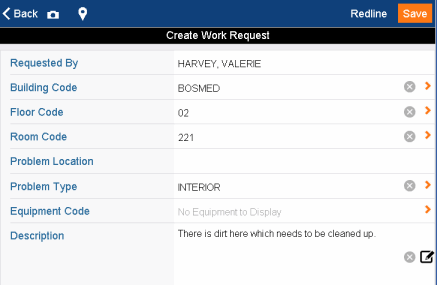
The craftsperson can create a work request from either the My Work or My Requests tab, as outlined below. If the craftsperson want to complete this job themselves they should enter it from the My Work screen so that the system can immediately assign the job to them; if they cannot work on this request, either because they don't have the skills or they don't have the time, they should report it from the My Requests tab so that the standard SLA system can process the request.
| If the craftsperson creates the request from this tab ... | ... the system processes the request by ... |
|---|---|
| My Work | assigning it to the craftsperson so that it appears in their work queue, bypassing the normal SLA process for assigning requests. The system will immediately show the request in the craftsperson's My Work tab. |
| My Requests | listing it in the My Requests screen with a status of Requested. When the craftsperson syncs, the system submits the request to the server where the appropriate SLA will process the request. |
Note: Work requests created from mobile automatically have their Priority set to 1.
Before they upload requests that they have made to the server, users may want to review requests that they entered and perhaps edit their initial data. Before they sync the device, they can review the list of work they have requested by choosing the My Requests tab. When they sync, the sync action uploads these requests to the server for processing by the maintenance system and the requests will no longer appear on the My Requests tab.
| Copyright © 1984-2016, ARCHIBUS, Inc. All rights reserved. |